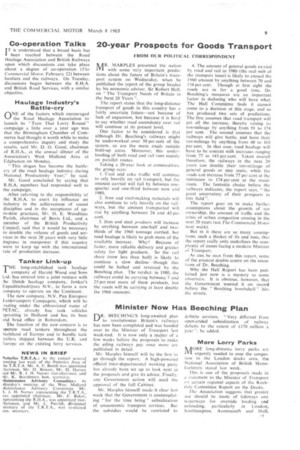20-year Prospects for Goods Transport
Page 11

If you've noticed an error in this article please click here to report it so we can fix it.
FROM OUR POLITICAL CORRESPONDENT
MR. MARPLES presented the nation with some very important predictions about the future of Britain's transport system on Wednesday, when he published the report of the group headed by his economic adviser, Sir Robert Hall, on The Transport Needs of Britain in the Next 20 Years ".
The report states that the long-distance transport of goods in this country has a fairly uncertain future—not because of lack of expansion, but because it is hard to say whether road ascendancy over rail Will continue at its present level.
One factor to be considered is that although Dr. Beeching's railways might be underworked over 50 per cent of the system, so are the main roads outside built-up areas. Moreover, this underloading Of both road and rail runs mainly on parallel routes.
Taking a 20-year look at commodities. the group says: • 1. Coal and coke traffic will continue to rely heavily on rail transport. but the amount carried will fall b. between onequarter and one-third between now and 1980.
2. Iron and steel-making materials* will also continue to rely heavily on the railways, but the amount transported will rise by anything between 24 and 43 per cent.
3. Iron and steel products will increase by anything between one-half and twothirds of the 1960 tonnage carried, but road haulage is likely to grab more of the available increase. Why? Because of faster, more reliable delivery and greater safety for light products. So the rail share (now less than half) is likely to continue a slow decline —though this could be halted and reversed by the Beeching plan. The verdict: in 1980, the railways could be carrying betweenl and 23 per cent more of these products, but the roads will be carrying at least double the 1960 amounts. 4. The amount of general goods carried by road and Tail in 1980 (the real nub of the transport issue) is likely to exceed the 1960 arhonnt by anything between 70 and 134 per cent. Though at first sight the roads are in for a good time, Dr. Beeching's, measures are an important factor in deducing who will have what. The Hall Committee .finds it cannot come to a decision at this stage, and so has produced two sets of predictions, The first assumes that road transport will get all the increase, thereby raising its ton-mileage by anything from 91 to 174 per cent. The second assumes that the railways will give battle, and hoist their ton-mileage by anything from 48 to 103 per cent. In that case, road haulage will have to be content with increases ranging from 77 to 143 per cent. Taken overall therefore, the railways in. the next 20 years Can double their ton-mileage of general goods or stay static, while the roads can increase from 77 per cent at the minimum to 174 percent the maximum. The fantastic choice before the railways indicates, the report says, the great uncertainty of their prospects in Ibis field ".
The report goes on to make further assumptions about the growth of car ownership, the amount of traffic and the crisis of urban congestion coming in the next 20 Years (see The Commercial Motor
next week).
But in it there are so many assumptions, such a thicket of ifs and buts, that the report really only underlines the complexity of issueslacing a modern Minister of Transport. • • As can_ be secn from this report, some of the greatest doubts centre on the intentions of Dr. Beeching. .
Why the Hall Report has been published just now is a mystery to some observers. It is obvious, however, that the Government Wanted it on record before the " Beeching bombshell" hit's the streets.




















































































































